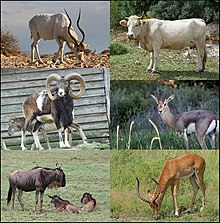
Back Horingdraers Afrikaans የቶራ አስተኔ Amharic Bovidae AN بقريات Arabic بقريات ARZ Bovidae AST Jaftol (Bovidae) AVK Boşbuynuzlular Azerbaijani بوش بوینوزلولار AZB Пустарогія Byelorussian
| Bovidae | |
|---|---|

| |
| Example Bovidae (clockwise from top left) – addax (Addax nasomaculatus), domestic cattle (Bos taurus), mountain gazelle (Gazella gazella), impala (Aepyceros melampus), blue wildebeest (Connochaetes taurinus), and mouflon (Ovis gmelini) | |
| Scientific classification | |
| Domain: | Eukaryota |
| Kingdom: | Animalia |
| Phylum: | Chordata |
| Class: | Mammalia |
| Order: | Artiodactyla |
| Infraorder: | Pecora |
| Superfamily: | Bovoidea |
| Family: | Bovidae Gray, 1821 |
| Type genus | |
| Bos | |
| Subfamilies | |
Alternate taxonomy:
| |
The Bovidae comprise the biological family of cloven-hoofed, ruminant mammals that includes cattle, yaks, bison, buffalo, antelopes (including goat-antelopes), sheep and goats. A member of this family is called a bovid. With 143 extant species and 300 known extinct species, the family Bovidae consists of 11 (or two) major subfamilies and thirteen major tribes. The family evolved 20 million years ago, in the early Miocene.
The bovids show great variation in size and pelage colouration. Except some domesticated forms, all male bovids have two or more horns, and in many species, females possess horns, too. The size and shape of the horns vary greatly, but the basic structure is always one or more pairs of simple bony protrusions without branches, often having a spiral, twisted or fluted form, each covered in a permanent sheath of keratin. Most bovids bear 30 to 32 teeth.
Most bovids are diurnal. Social activity and feeding usually peak during dawn and dusk. Bovids typically rest before dawn, during midday, and after dark. They have various methods of social organisation and social behaviour, which are classified into solitary and gregarious behaviour. Bovids use different forms of vocal, olfactory, and tangible communication. Most species alternately feed and ruminate throughout the day. While small bovids forage in dense and closed habitat, larger species feed on high-fiber vegetation in open grasslands. Most bovids are polygynous. Mature bovids mate at least once a year and smaller species may even mate twice. In some species, neonate bovids remain hidden for a week to two months, regularly nursed by their mothers; in other species, neonates are followers, accompanying their dams, rather than tending to remain hidden.
The greatest diversities of bovids occur in Africa. The maximum concentration of species is in the savannas of Eastern Africa. Other bovid species also occur in Europe, Asia, and North America. Bovidae includes three of the five domesticated mammals whose use has spread outside their original ranges, namely cattle, sheep, and goats. Dairy products, such as milk, butter, and cheese, are manufactured largely from domestic cattle. Bovids are also raised for their leather, meat, and wool.
© MMXXIII Rich X Search. We shall prevail. All rights reserved. Rich X Search